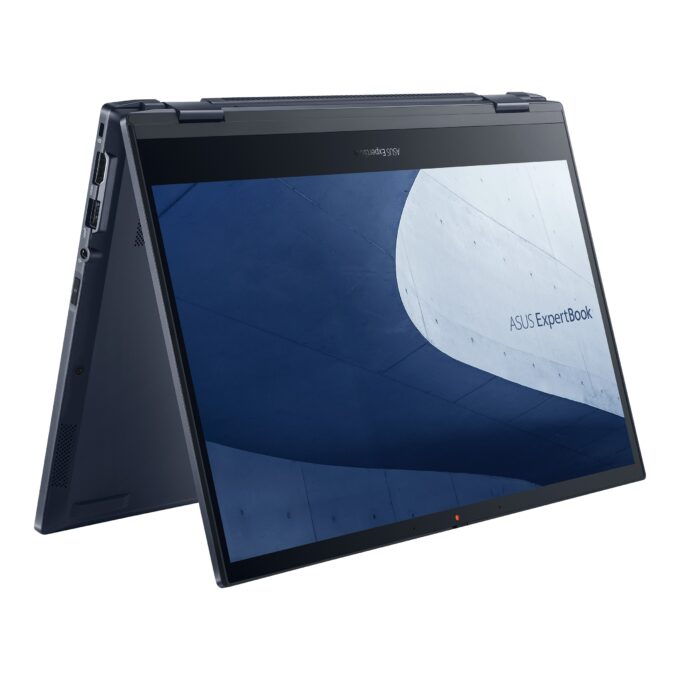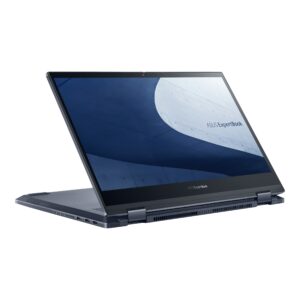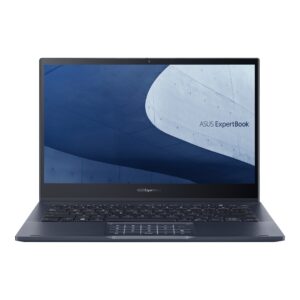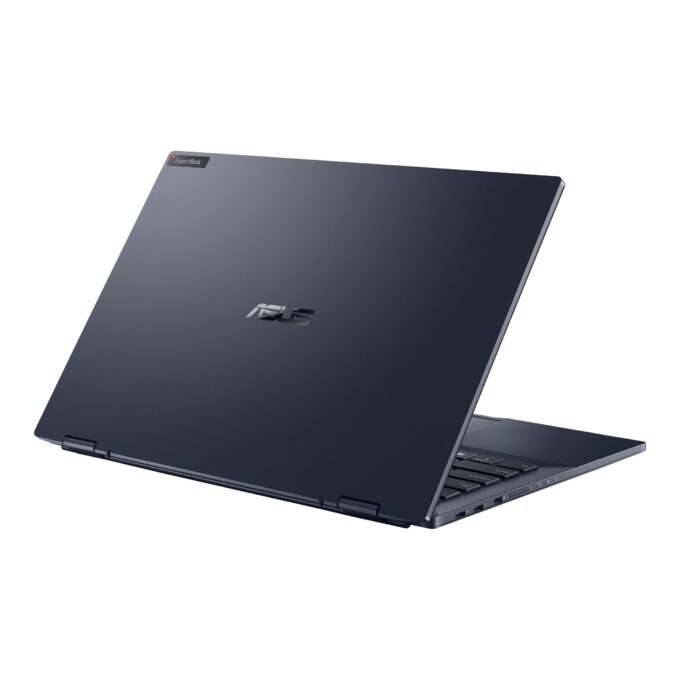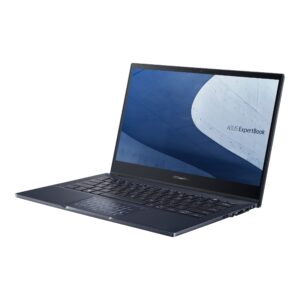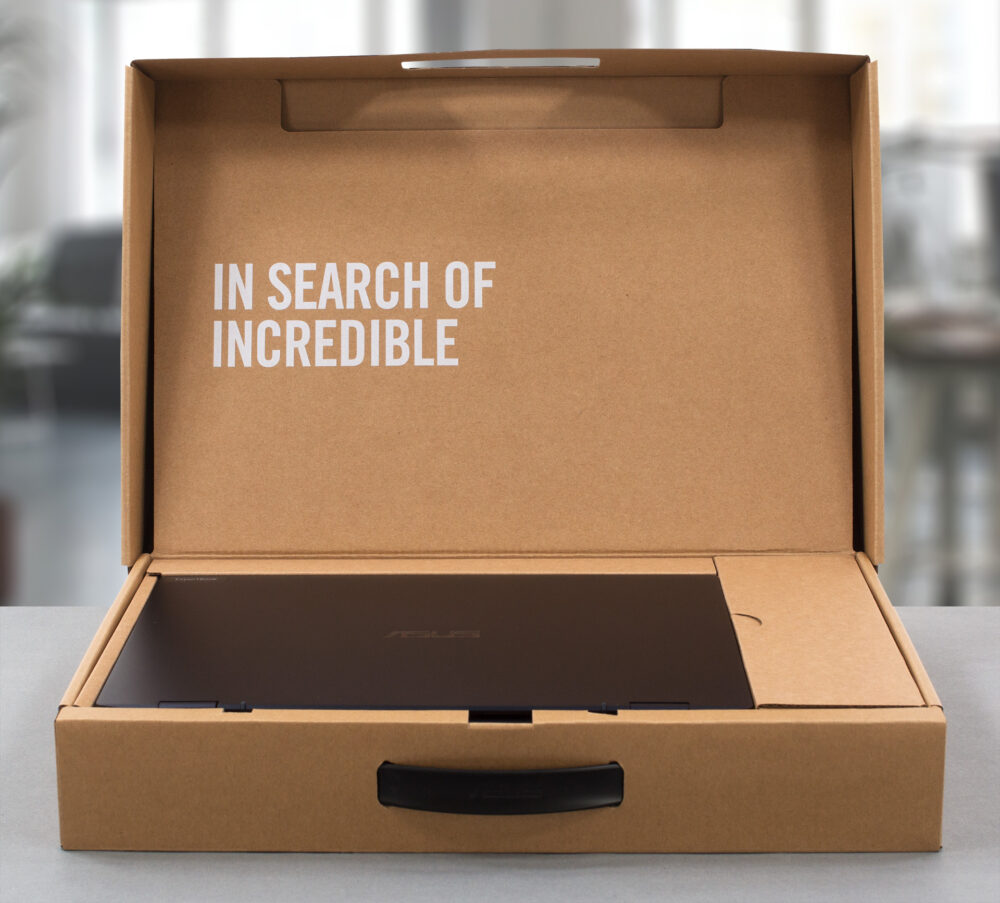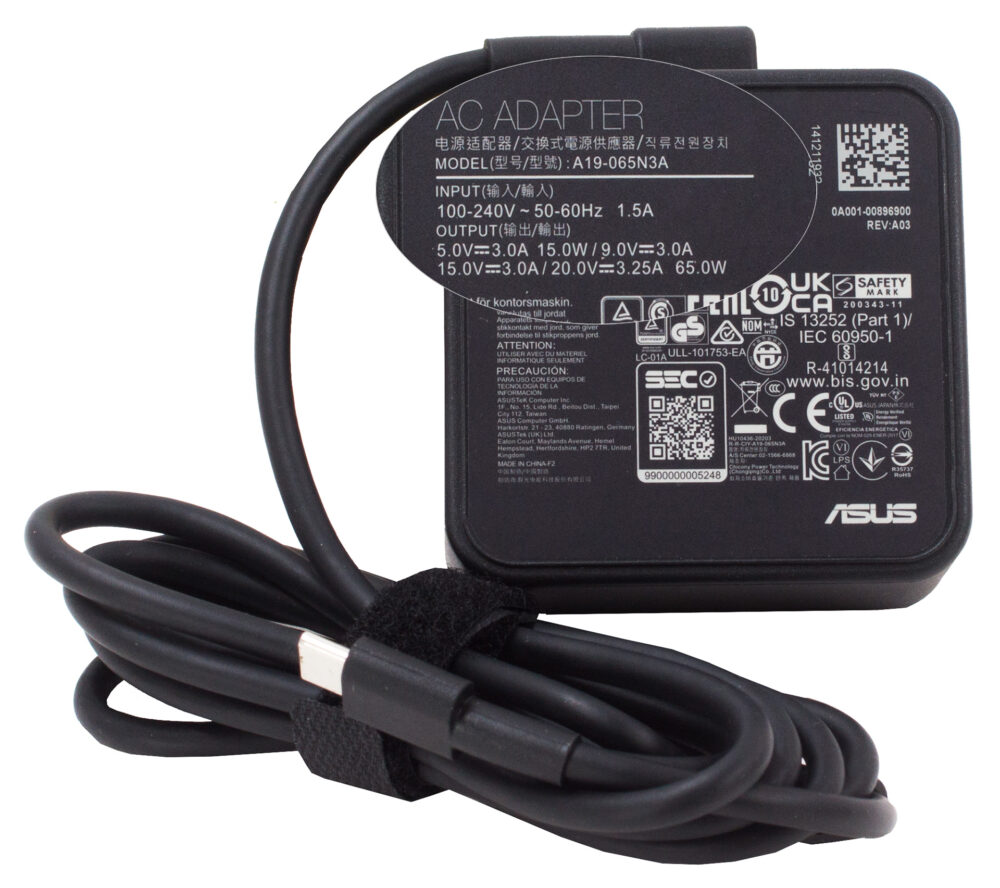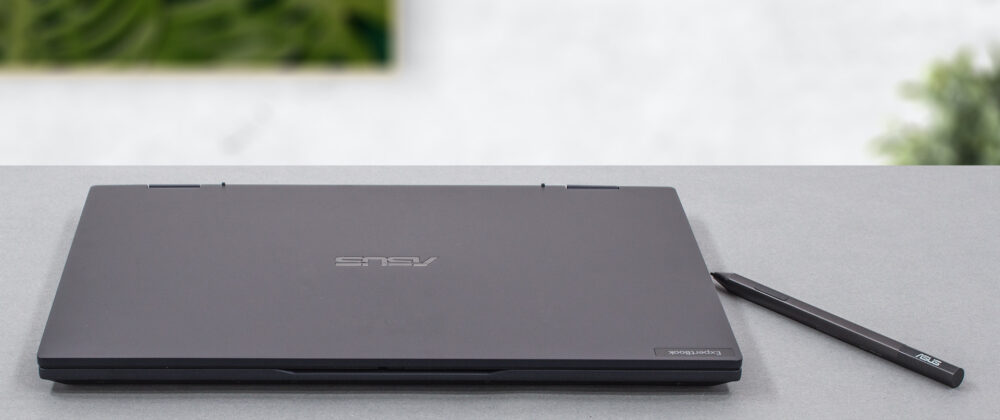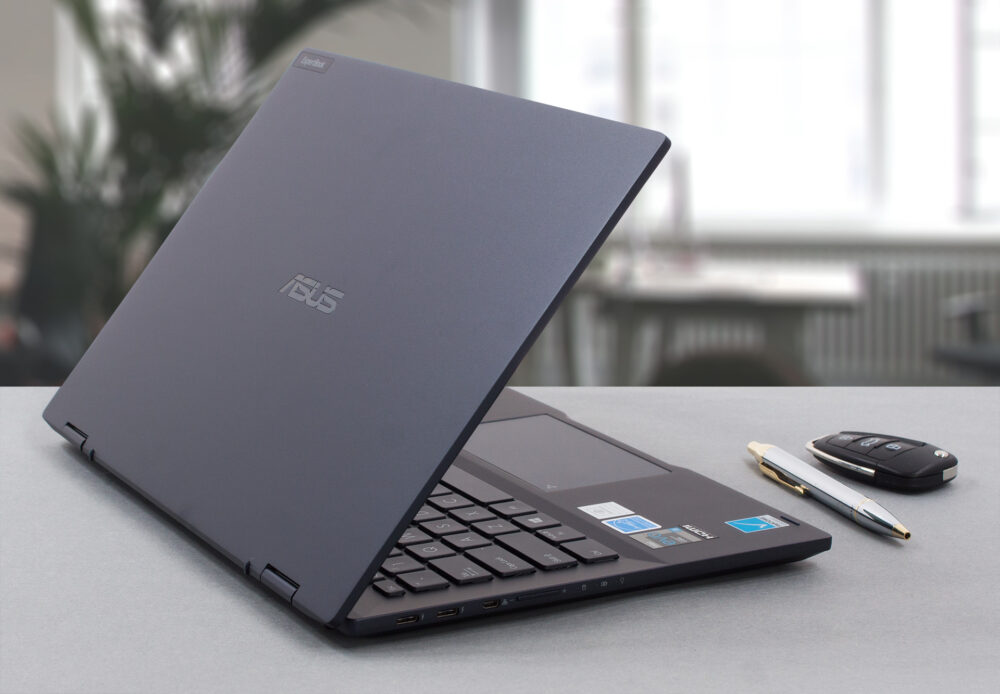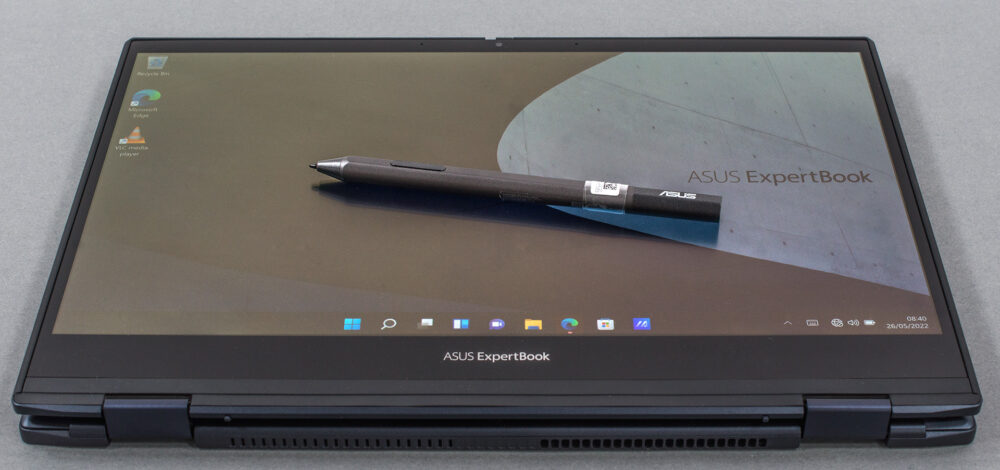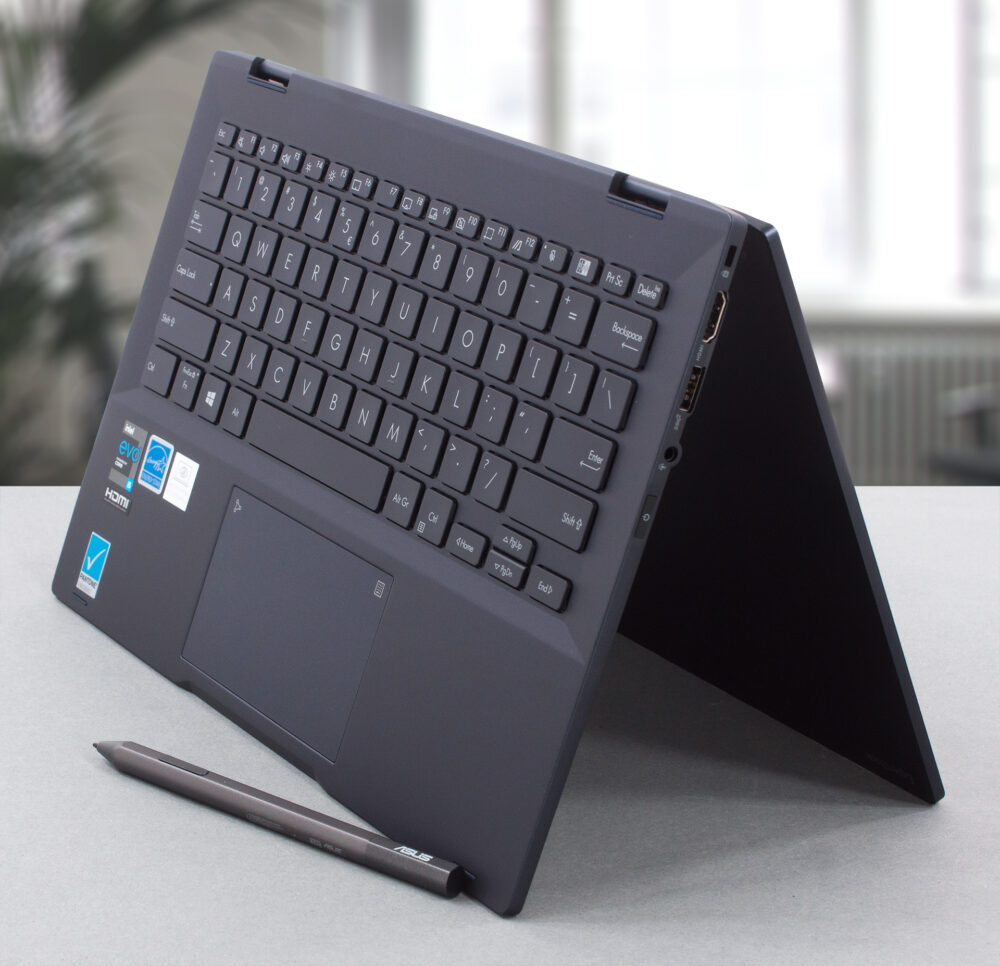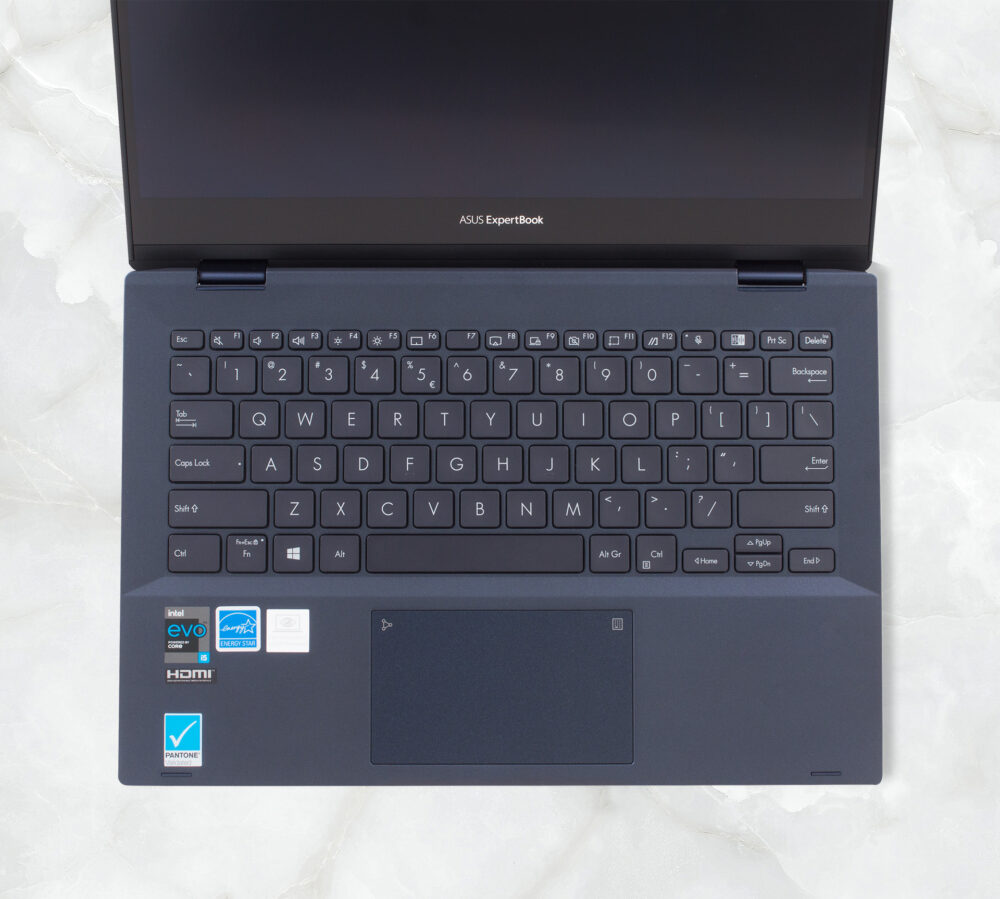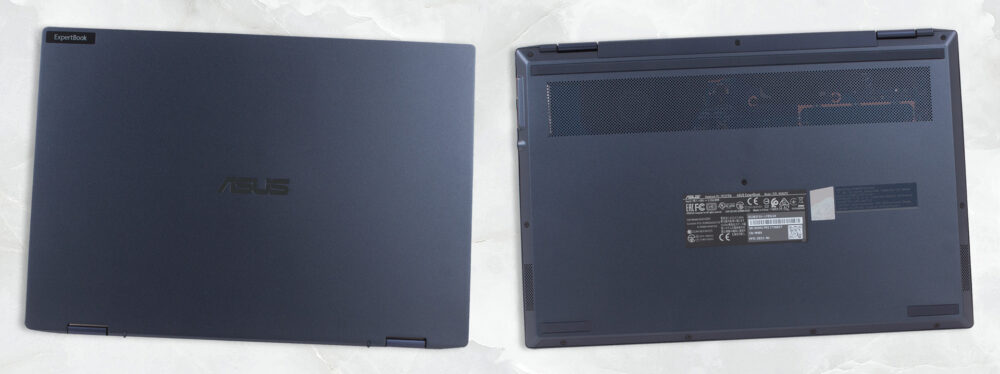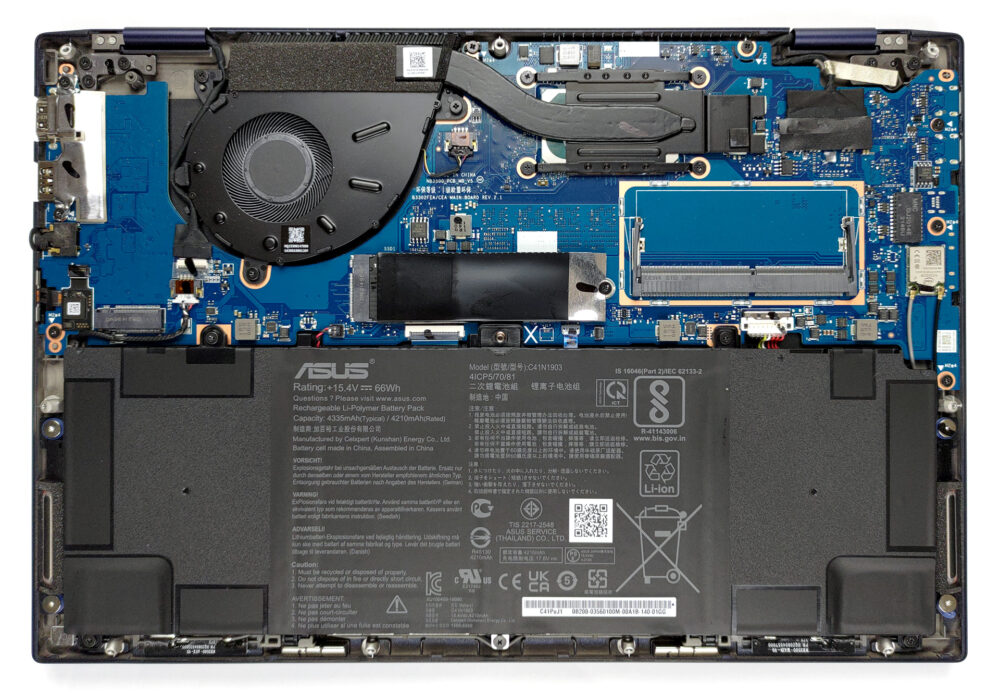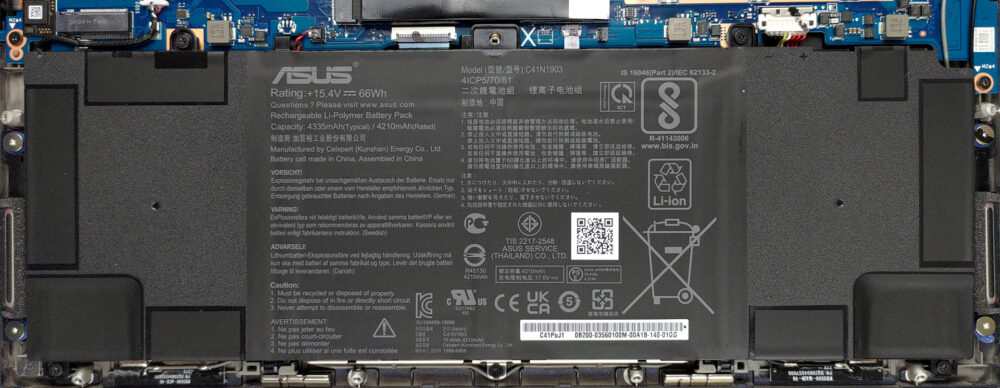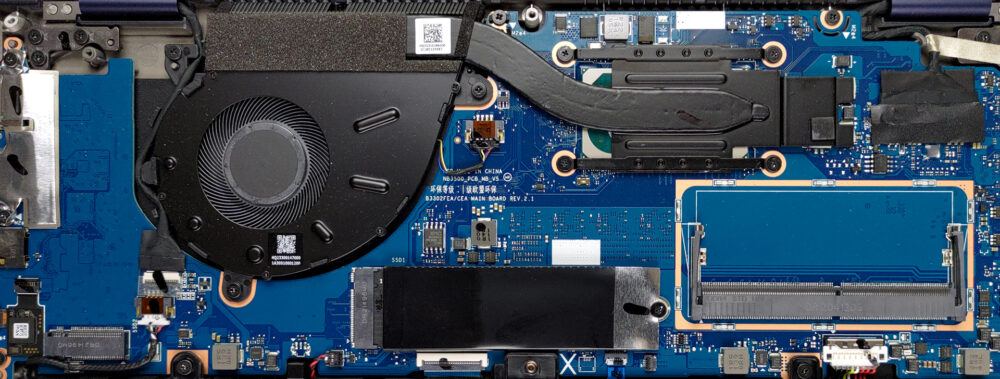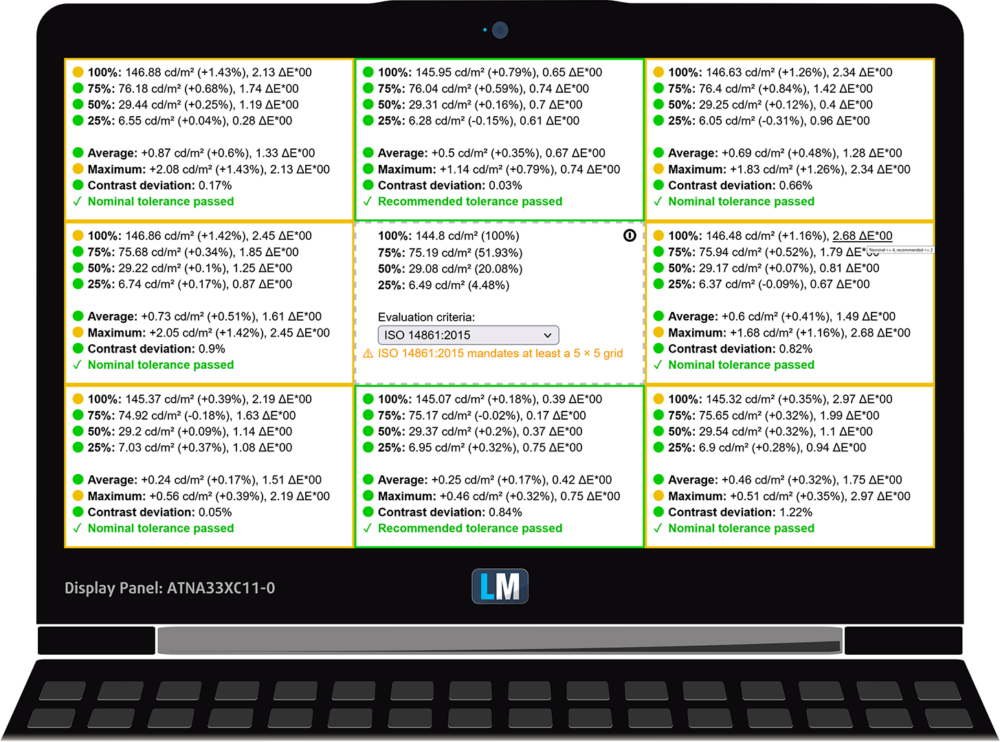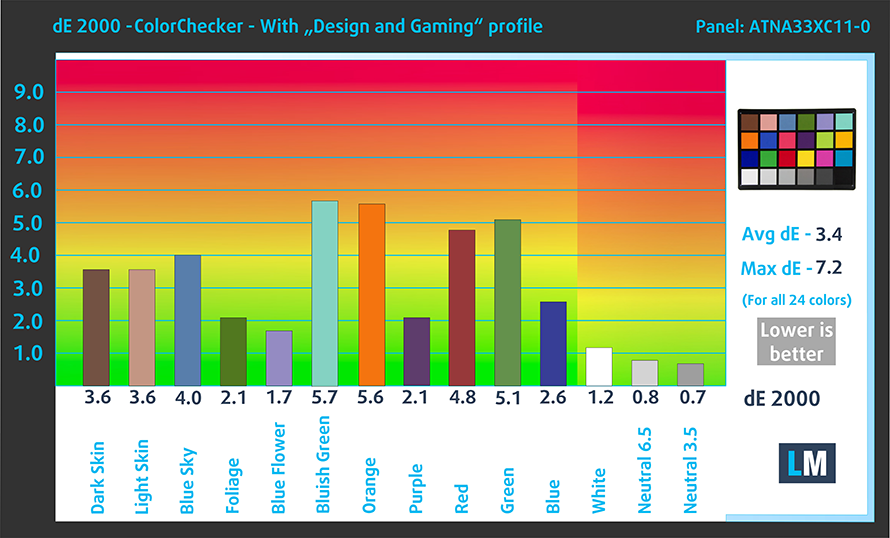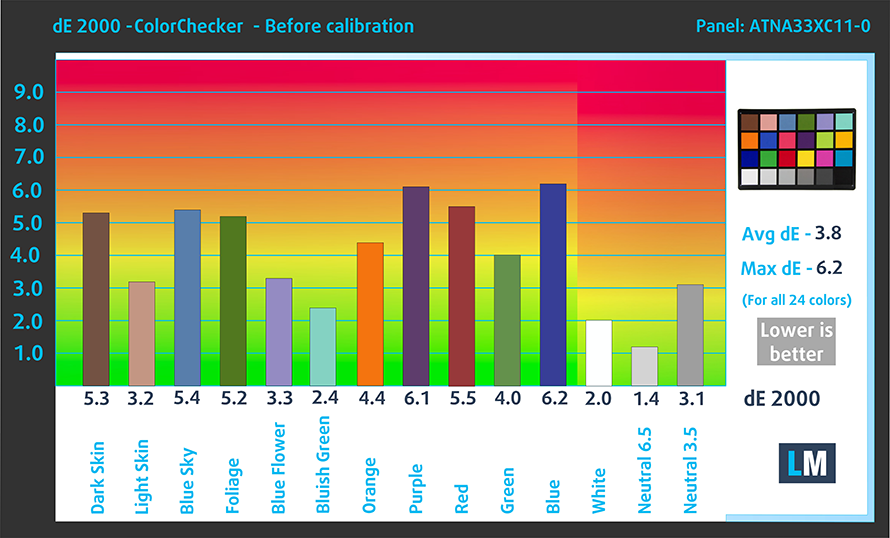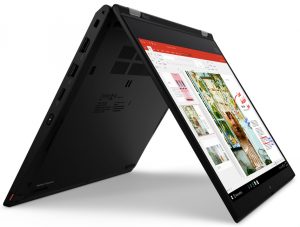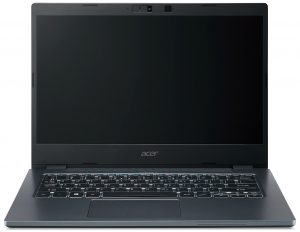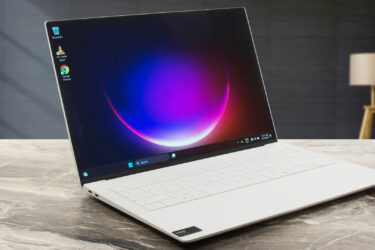ASUS ExpertBook B5 Flip (B5302F) review
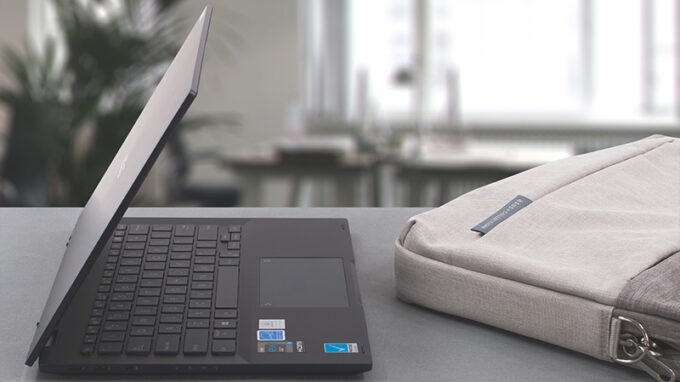 Did you know that ASUS has one of the highest user satisfaction scores when it comes to business notebooks? This is really interesting, given the fact that the ExpertBook series is fairly new to the market, compared to the Latitudes and ThinkPads out there. This can only mean one thing – ASUS is doing it right.
Did you know that ASUS has one of the highest user satisfaction scores when it comes to business notebooks? This is really interesting, given the fact that the ExpertBook series is fairly new to the market, compared to the Latitudes and ThinkPads out there. This can only mean one thing – ASUS is doing it right.
One device that has little to prove but a lot to offer is the ExpertBook B5 Flip (B5302F). The device that we got ourselves is equipped with an OLED panel but unlike most of the OLED laptops out there, this one has an anti-glare finish that works.
Although we found ourselves on the brink of another processor revolution, this little machine comes with Tiger Lake processors on board. Arguably, this is a safe choice for small or medium businesses. Furthermore, the Evo platform offers additional stability.
You can check the prices and configurations in our Specs System: https://laptopmedia.com/series/asus-expertbook-b5-flip-b5302f/
Contents
Specs Sheet
- HDD/SSD
- up to 1000GB SSD
- M.2 Slot
- 2x 2280 PCIe NVMe 3.0 x4 See photo
- RAM
- up to 16GB
- OS
- Windows 10 Pro, Windows 11 Home, Windows 11 Pro
- Battery
- 66Wh, 4-cell
- Body material
- Aluminum, Magnesium alloy
- Dimensions
- 309 x 210.6 x 16.9 mm (12.17" x 8.29" x 0.67")
- Weight
- 1.11 kg (2.4 lbs)
- Ports and connectivity
- 1x USB Type-A
- 3.2 Gen 2 (10 Gbps)
- 2x USB Type-C
- Power Delivery (PD), DisplayPort
- HDMI
- 2.0b
- Card reader
- MicroSD
- Ethernet LAN
- Wi-Fi
- 802.11ax
- Bluetooth
- 5.0
- Audio jack
- 3.5mm Combo Jack
- Features
- Fingerprint reader
- optional
- Web camera
- HD
- Backlit keyboard
- optional
- Microphone
- Array Microphone with Cortana Support
- Speakers
- Speaker with Smart Amp
- Optical drive
- Security Lock slot
All ASUS ExpertBook B5 Flip (B5302F, 11th Gen Intel) configurations
What’s in the box?
Besides the paperwork, inside the package, we found a 65W USB Type-C power adapter, a dedicated stylus, as well as a micro HDMI to LAN port dongle.
Design and construction
Although ASUS hasn’t made the laptop look flashy, it has used high-quality materials. This includes aluminum for the lid and bottom panel, as well as a magnesium-aluminum alloy for the base. This results in a weight that goes from 1.11 kg up to 1.31 kg, depending on the configuration.
Both the lid and the base are very sturdy, which is exceptional, given the 16.9mm thickness of the device. Without a doubt, this is one of the biggest advantages of this laptop.
Unfortunately, the lid can’t be opened with a single hand. Also, the top and bottom bezels are surprisingly thick. On the bright side, the top one features an HD Web camera with a privacy shutter.
In addition to that, the laptop sports a leverage mechanism that lifts the backside of the base gently off the ground. Naturally, the lid works great with the included stylus.
Moving to the keyboard, we see a unit that has an optional backlight. Well, in our case, the backlight is not present. Nevertheless, it is spill-resistant and has long key travel, which is complemented by clicky feedback. This results in a very comfortable typing experience.
Once again, there is a NumberPad embedded in the touchpad. It works like a charm, and even though the unit is small, it offers great gliding and accurate tracking.
Naturally, the bottom panel houses the speaker cutouts and the quite big ventilation grill. The hot air is then exhausted through a vent in between the lid and the base.
Ports
On the left side, you’ll find two Thunderbolt 4 connectors, a micro HDMI port, and a volume rocker. Then, on the right, there is a Kensington lock slot, an HDMI 2.0b connector, a USB Type-A 3.2 (Gen. 2) port, an audio jack, and the power button with an optional fingerprint reader embedded into it.
Disassembly, upgrade options and maintenance
To get inside this notebook, you’ll need to undo all 10 Phillips-head screws. After that, pry the bottom panel with a plastic tool, and remove it from the chassis.
Our device is equipped with a 66Wh battery pack. If you want to take it out, unplug the battery connector, and undo all 4 Phillips-head screws holding it to the chassis.
There are either 4, 8, or 16GB soldered to the motherboard, with a single SODIMM slot offering further expansion. Interestingly, the storage options include two M.2 PCIe x4 slots, which can work in RAID mode.
The cooling here comprises a single heat pipe, a heat sink, and a small fan. In addition, you get some cooling over the VRMs too.
Display quality
ASUS ExpertBook B5 Flip (B5302F) is equipped with a Full HD OLED panel, Samsung ATNA33XC11-0 (SDC4158). Its diagonal is 13.3-inch (33.78 cm), and the resolution – 1920 х 1080p. Additionally, the screen ratio is 16:9, the pixel density – 166 ppi, their pitch – 0.15 х 0.15 mm. The screen can be considered Retina when viewed from at least 50 cm (from this distance, the average human eye can’t see the individual pixels).
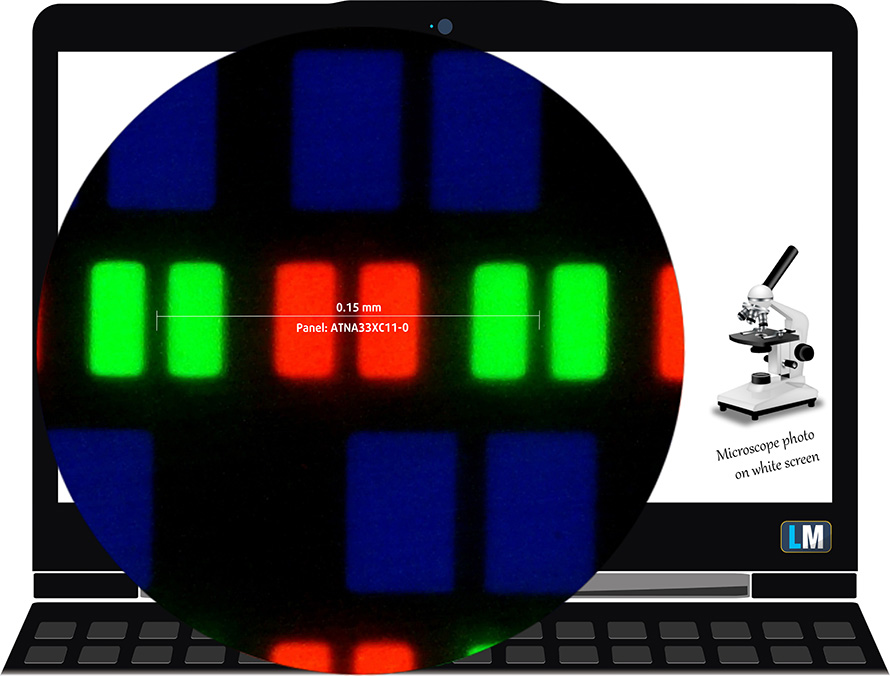
Viewing angles are comfortable. We offer images at different angles to evaluate the quality.
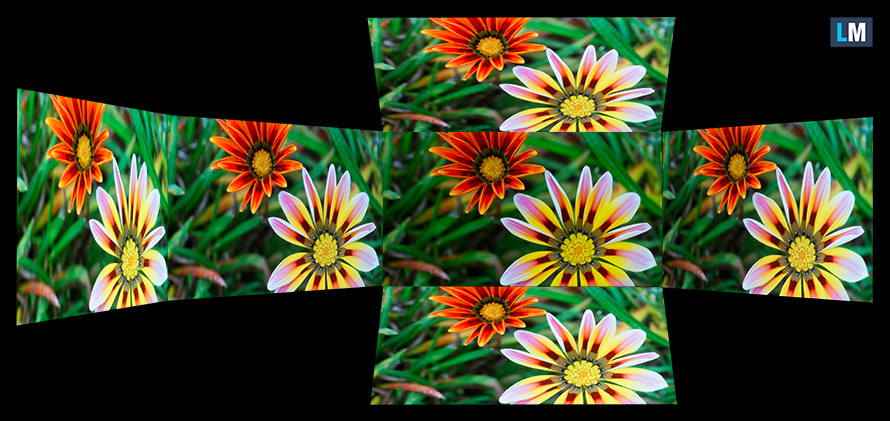
Also, a video with locked focus and exposure.
The maximum measured brightness is 387 nits (cd/m2) in the middle of the screen and 387 nits (cd/m2) average across the surface with a maximum deviation of just 4% (Splendid – “Normal” in MyASUS). The Correlated Color Temperature on a white screen and at maximum brightness is 6480K – matching the 6500K temperature for sRGB.
In the illustration below you can see how the display performs from a uniformity perspective.
Values of dE2000 over 4.0 should not occur, and this parameter is one of the first you should check if you intend to use the laptop for color-sensitive work (a maximum tolerance of 2.0 ). The contrast ratio here is incomparably better than that of the IPS and TN panels and is mathematically infinite.
To make sure we are on the same page, we would like to give you a little introduction to the sRGB color gamut and the Adobe RGB. To start, there’s the CIE 1976 Uniform Chromaticity Diagram that represents the visible specter of colors by the human eye, giving you a better perception of the color gamut coverage and the color accuracy.
Inside the black triangle, you will see the standard color gamut (sRGB) that is being used by millions of people on HDTV and on the web. As for the Adobe RGB, this is used in professional cameras, monitors, etc for printing. Basically, colors inside the black triangle are used by everyone and this is the essential part of the color quality and color accuracy of a mainstream notebook.
Still, we’ve included other color spaces like the famous DCI-P3 standard used by movie studios, as well as the digital UHD Rec.2020 standard. Rec.2020, however, is still a thing of the future and it’s difficult for today’s displays to cover that well. We’ve also included the so-called Michael Pointer gamut, or Pointer’s gamut, which represents the colors that naturally occur around us every day.
The yellow dotted line shows ASUS ExpertBook B5 Flip (B5302F)’s color gamut coverage.
Its display covers 100% of the sRGB/ITU-R BT.709 (web/HDTV standard) in CIE1976, and 100% of DCI-P3 providing a punchy and vibrant image.
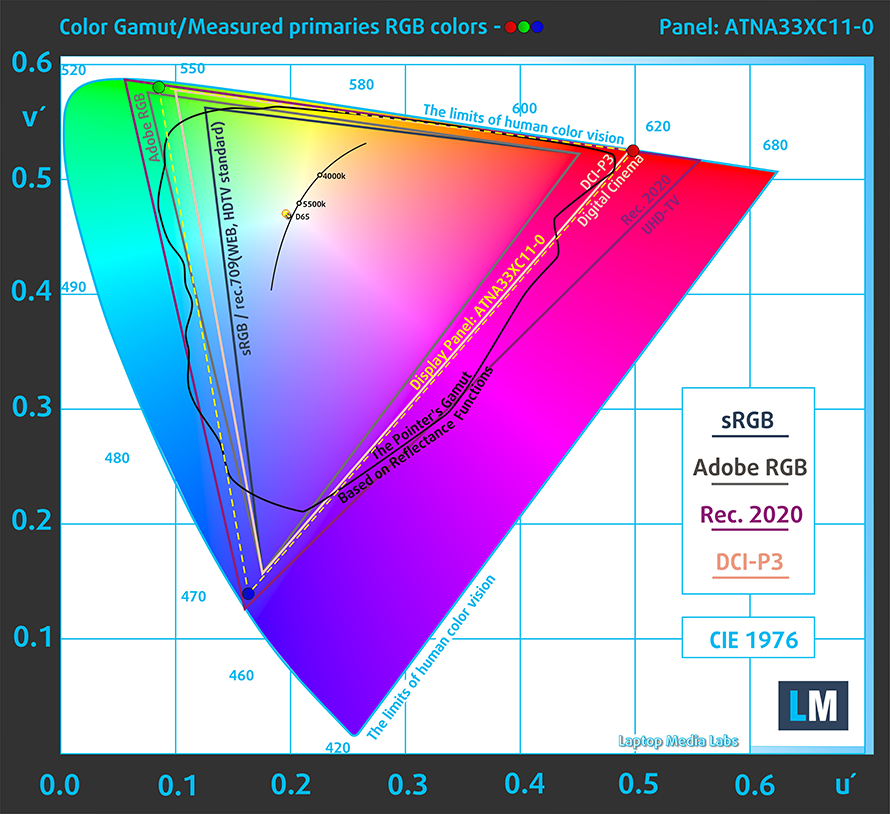
Our “Design and Gaming” profile delivers optimal color temperature (6500K) at 140 cd/m2 luminance and sRGB gamma mode.
We tested the accuracy of the display with 24 commonly used colors like light and dark human skin, blue sky, green grass, orange, etc. You can check out the results at factory condition and also, with the “Design and Gaming” profile.
Below you can compare the scores of ASUS ExpertBook B5 Flip (B5302F) with the default settings (left), and with the “Gaming and Web design” profile (right).
You can also compare the default setting with the “OLED Flicker-Free Dimming – 50%” inside the P3-D65 color space.
The next figure shows how well the display is able to reproduce really dark parts of an image, which is essential when watching movies or playing games in low ambient light.
The left side of the image represents the display with stock settings, while the right one is with the “Gaming and Web Design” profile activated. On the horizontal axis, you will find the grayscale, and on the vertical axis – the luminance of the display. On the two graphs below you can easily check for yourself how your display handles the darkest nuances but keep in mind that this also depends on the settings of your current display, the calibration, the viewing angle, and the surrounding light conditions.
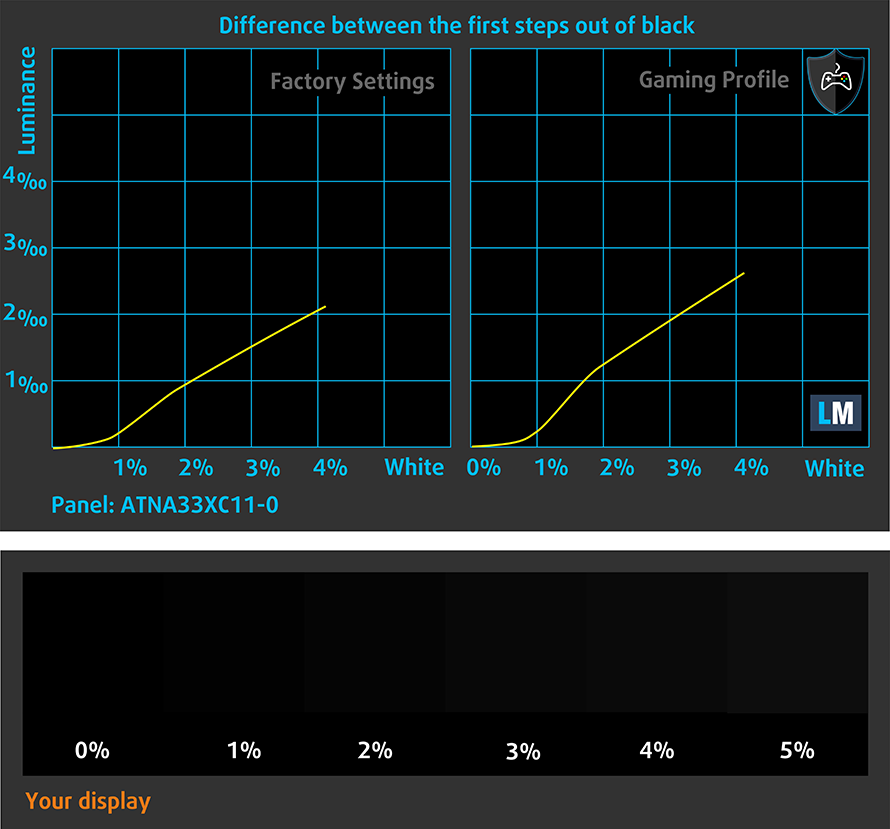
Response time (Gaming capabilities)
We test the reaction time of the pixels with the usual “black-to-white” and “white-to-black” method from 10% to 90% and vice versa.
We recorded Fall Time + Rise Time = 4 ms.
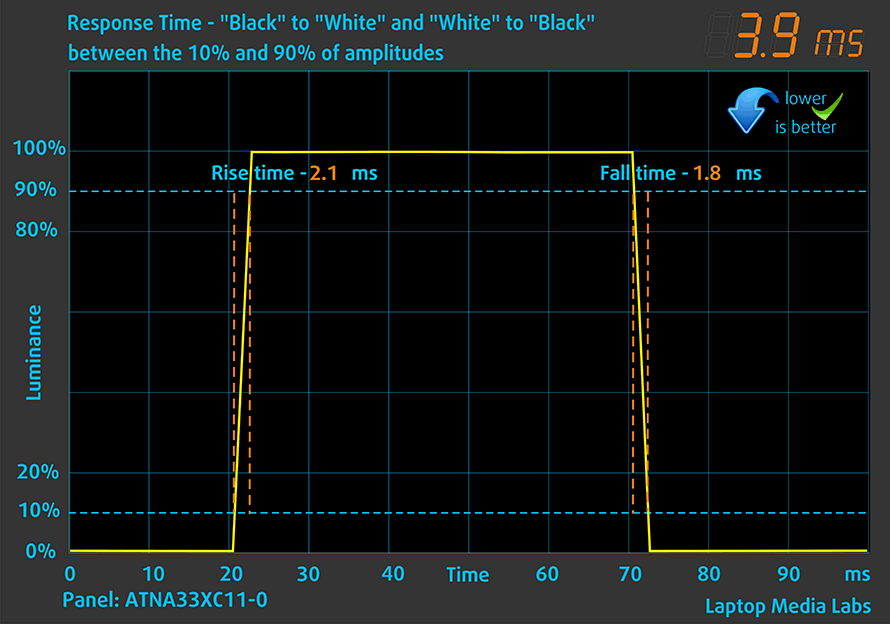
After that, we test the reaction time of the pixels with the usual “Gray-to-Gray” method from 50% White to 80% White and vice versa between 10% and 90% of the amplitude.
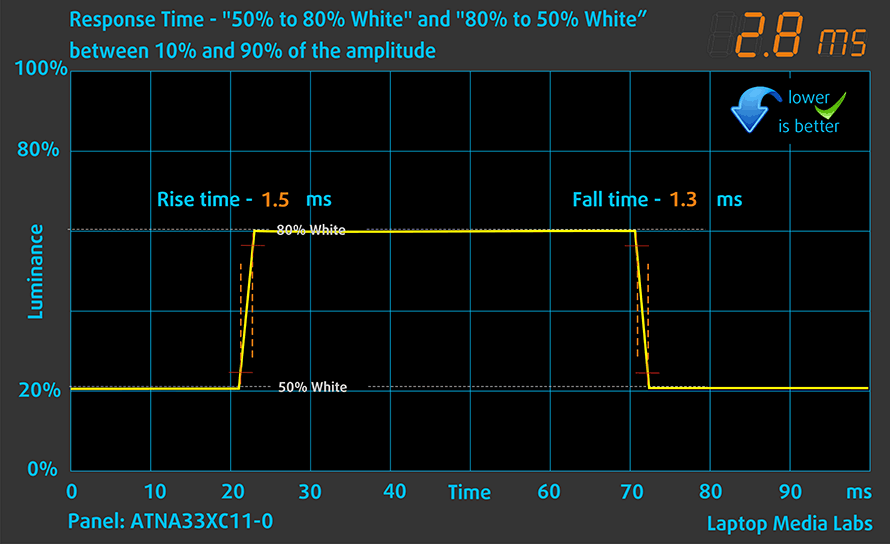
Health impact – PWM / Blue Light
PWM (Screen flickering)
Pulse-width modulation (PWM) is an easy way to control monitor brightness. When you lower the brightness, the light intensity of the backlight is not lowered, but instead turned off and on by the electronics with a frequency indistinguishable to the human eye. In these light impulses, the light/no-light time ratio varies, while brightness remains unchanged, which is harmful to your eyes. You can read more about that in our dedicated article on PWM.
ASUS ExpertBook B5 Flip (B5302F)’s panel uses low-frequency PWM for brightness adjustment up until 90 nits, after which we detect very mild pulsations. Above that brightness, the display can be considered safe in this aspect. As you can see from the last two segments of the image, the “OLED Flicker-Free Dimming” does its job perfectly.

Blue light emissions
Installing our Health-Guard profile not only eliminates PWM but also reduces the harmful Blue Light emissions while keeping the colors of the screen perceptually accurate. If you’re not familiar with the Blue light, the TL;DR version is – emissions that negatively affect your eyes, skin, and your whole body. You can find more information about that in our dedicated article on Blue Light.
Buy our profiles
Since our profiles are tailored for each individual display model, this article and its respective profile package are meant for ASUS ExpertBook B5 Flip (B5302F) configurations with 13.3″ Samsung ATNA33XC11-0 (SDC4158) (FHD, 1920 × 1080) OLED panel.
*Should you have problems with downloading the purchased file, try using a different browser to open the link you’ll receive via e-mail. If the download target is a .php file instead of an archive, change the file extension to .zip or contact us at [email protected].
Read more about the profiles HERE.
In addition to receiving efficient and health-friendly profiles, by buying LaptopMedia's products you also support the development of our labs, where we test devices in order to produce the most objective reviews possible.

Office Work
Office Work should be used mostly by users who spend most of the time looking at pieces of text, tables or just surfing. This profile aims to deliver better distinctness and clarity by keeping a flat gamma curve (2.20), native color temperature and perceptually accurate colors.

Design and Gaming
This profile is aimed at designers who work with colors professionally, and for games and movies as well. Design and Gaming takes display panels to their limits, making them as accurate as possible in the sRGB IEC61966-2-1 standard for Web and HDTV, at white point D65.

Health-Guard
Health-Guard eliminates the harmful Pulse-Width Modulation (PWM) and reduces the negative Blue Light which affects our eyes and body. Since it’s custom tailored for every panel, it manages to keep the colors perceptually accurate. Health-Guard simulates paper so the pressure on the eyes is greatly reduced.
Get all 3 profiles with 33% discount
Sound
ASUS ExpertBook B5 Flip (B5302F)’s speakers produce a crisp sound with good quality. The chart below shows a slight dip in the low tones.
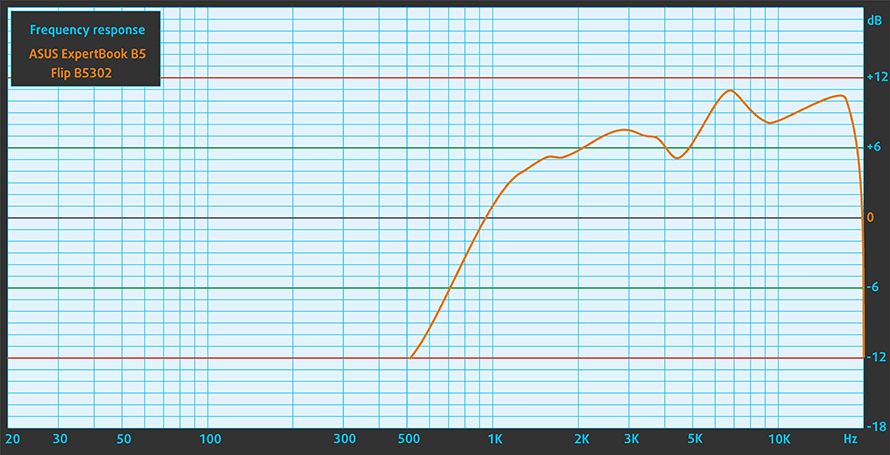
Drivers
All drivers and utilities for this notebook can be found here: https://www.asus.com/Laptops/For-Work/ExpertBook/ExpertBook-B5-Flip-B5302F-11th-Gen-Intel/HelpDesk_Download/
Battery
Now, we conduct the battery tests with the Windows Better performance setting turned on, screen brightness adjusted to 120 nits, and all other programs turned off except for the one we are testing the notebook with. The 66Wh battery pack here lasts for 12 hours and 27 minutes of Web browsing, or 10 hours and 50 minutes of video playback.
In order to simulate real-life conditions, we used our own script for automatic web browsing through over 70 websites.
For every test like this, we use the same video in HD.
CPU options
This machine comes with the Holy Trinity of Tiger Lake-U processors – Core i3-1115G4, Core i5-1135G7, or Core i7-1165G7.
Results are from the Cinebench 20 CPU test (the higher the score, the better)
Results are from our Photoshop benchmark test (the lower the score, the better)
GPU options
Since there are no dedicated graphics choices, you get the quite capable integrated Iris Xe Graphics G4 or G7.
Results are from the 3DMark: Time Spy (Graphics) benchmark (higher the score, the better)
Results are from the 3DMark: Fire Strike (Graphics) benchmark (higher the score, the better)
Results are from the 3DMark: Wild Life benchmark (higher the score, the better)
Results are from the Unigine Superposition benchmark (higher the score, the better)
Gaming tests

| CS:GO | HD 1080p, Low (Check settings) | HD 1080p, Medium (Check settings) | HD 1080p, MAX (Check settings) |
|---|---|---|---|
| Average FPS | 101 fps | 74 fps | 37 fps |

| DOTA 2 | HD 1080p, Low (Check settings) | HD 1080p, Normal (Check settings) | HD 1080p, High (Check settings) |
|---|---|---|---|
| Average FPS | 112 fps | 72 fps | 39 fps |
Temperatures and comfort
Max CPU load
In this test we use 100% on the CPU cores, monitoring their frequencies and chip temperature. The first column shows a computer’s reaction to a short load (2-10 seconds), the second column simulates a serious task (between 15 and 30 seconds), and the third column is a good indicator of how good the laptop is for long loads such as video rendering.
Average core frequency (base frequency + X); CPU temp.
| Intel Core i5-1135G7 (15W TDP) | 0:02 – 0:10 sec | 0:15 – 0:30 sec | 10:00 – 15:00 min |
|---|---|---|---|
| ASUS ExpertBook B5 Flip (B5302F) | 3.40 GHz (B+42%) @ 93°C @ 40W | 2.96 GHz (B+23%) @ 94°C @ 30W | 2.51 GHz (B+5%) @ 80°C @ 22W |
| Lenovo V17 Gen 2 | 3.65 GHz (B+52%) @ 92°C @ 53W | 3.20 GHz (B+33%) @ 89°C @ 41W | 2.48 GHz (B+3%) @ 66°C @ 25W |
| HP 470 G8 | 3.09 GHz (B+29%) @ 79°C @ 31W | 2.60 GHz (B+8%) @ 80°C @ 24W | 2.42 GHz (B+1%) @ 78°C @ 18W |
| Dynabook Tecra A50-J | 3.77 GHz (B+57%) @ 97°C @ 52W | 3.22 GHz (B+34%) @ 87°C @ 36W | 2.82 GHz (B+18%) @ 76°C @ 28W |
| Dynabook Tecra A40-J | 3.74 GHz (B+56%) @ 96°C @ 51W | 3.21 GHz (B+34%) @ 86°C @ 36W | 2.91 GHz (B+21%) @ 77°C @ 28W |
| HP ProBook 430 G8 | 3.32 GHz (B+38%) @ 97°C @ 35W | 2.74 GHz (B+14%) @ 89°C @ 24W | 2.29 GHz (B-5%) @ 75°C @ 17W |
| Acer Swift 3 (SF314-511) | 3.15 GHz (B+31%) @ 91°C @ 34W | 2.89 GHz (B+20%) @ 91°C @ 28W | 2.69 GHz (B+12%) @ 91°C @ 25W |
| Microsoft Surface Laptop 4 (13.5) | 3.80 GHz (B+58%) @ 80°C @ 46W | 3.62 GHz (B+51%) @ 89°C @ 43W | 1.99 GHz (B-17%) @ 60°C @ 13W |
| ASUS VivoBook 15 OLED K513 | 3.39 GHz (B+41%) @ 83°C @ 40W | 3.28 GHz (B+34%) @ 91°C @ 37W | 2.96 GHz (B+23%) @ 85°C @ 28W |
| MSI Summit E13 Flip Evo | 3.65 GHz (B+52%) @ 96°C @ 45W | 3.31 GHz (B+38%) @ 96°C @ 47W | 3.03 GHz (B+25%) @ 96°C @ 29W |
| Dell XPS 13 9310 (2-in-1) | 3.36 GHz (B+40%) @ 99°C @ 41W | 3.16 GHz (B+32%) @ 99°C @ 37W | 1.92 GHz @ 72°C @ 16W |
| Dell XPS 13 9310 | 3.15 GHz (B+31%) @ 100°C @ 40W | 2.73 GHz (B+14%) @ 100°C @ 30W | 1.65 GHz @ 73°C @ 15W |
| Dell Vostro 14 5402 | 3.02 GHz (B+26%) @ 99°C @ 29W | 2.61 GHz (B+9%) @ 99°C @ 25W | 2.00 GHz @ 76°C @ 15W |
| MSI Modern 15 (A11X) | 3.59 GHz (B+50%) @ 94°C @ 44W | 3.45 GHz (B+44%) @ 95°C @ 40W | 3.18 GHz (B+33%) @ 91°C @ 34W |
| Lenovo ThinkBook 14s Yoga | 3.52 GHz (B+47%) @ 94°C | 3.24 GHz (B+35%) @ 94°C | 2.63 GHz (B+10%) @ 75°C |
| Lenovo Yoga 7 (14) | 3.34 GHz (B+39%) @ 94°C | 2.97 GHz (B+24%) @ 94°C | 2.39 GHz @ 75°C |
| Acer Aspire 5 (A514-54) | 3.54 GHz (B+48%) @ 87°C | 2.01 GHz @ 66°C | 2.03 GHz @ 67°C |
Despite its small form factor, the ExpertBook B5 Flip can sustain Core i5-1135G7’s base clock through the unbreakable time strings of infinity. It is interesting that its fan starts spinning only after 10-15 seconds after we started Prime95. This is what you want from a business machine. Basically, you may never hear the fan in day-to-day work.
Gaming comfort
In addition to that, the device is pretty cool on the outside. The hotspot on the keyboard never goes higher than 38°C.
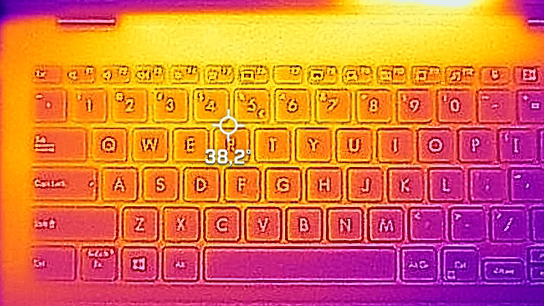
Verdict
 We’ve said that numerous times, and we’ll say it again – there is no perfect laptop out there. And there will never be. However, the ExpertBook B5 Flip (B5302F) is one, which will more than satisfy your business needs. The first good impression we got was even before we had the laptop on our hands – its price. We can say that it is pretty affordable for a convertible OLED-equipped 13-incher.
We’ve said that numerous times, and we’ll say it again – there is no perfect laptop out there. And there will never be. However, the ExpertBook B5 Flip (B5302F) is one, which will more than satisfy your business needs. The first good impression we got was even before we had the laptop on our hands – its price. We can say that it is pretty affordable for a convertible OLED-equipped 13-incher.
Speaking of which, ASUS ExpertBook B5 Flip (B5302F)’s touchscreen OLED panel has a Full HD resolution, comfortable viewing angles, and true blacks thanks to the practically infinite contrast ratio. Furthermore, it covers 100% of both the sRGB and the DCI-P3 color gamuts, which results in an attractive and vibrant image. Its pixel response times are absolutely amazing, while the DC dimming feature almost fully eliminates the flickering.
In addition to the fantastic display, you get very good battery life. The 66Wh package should last you for more than 12 hours of Web browsing or nearly 11 hours of video playback. This means you should be comfortable at work even if you forget your charger. On the other hand, we wouldn’t forget it, because it is a 65W USB Type-C unit, which can charge your phone too!
The port selection here is also good with two Thunderbolt 4 connectors, an HDMI port, a regular USB port, and a micro HDMI connector, that splits to a LAN port via the dongle ASUS provides inside the box. By the way, you get a stylus too. And what makes the deal even sweeter, is that you have the option to put two M.2 PCIe x4 SSDs in RAID mode. Inside of a 13-inch convertible! Who else, but ASUS?
Yes, there are some disadvantages, like the optional backlight – why not make it a standard for all units? Also, there is no IR face recognition option, which could have easily been. These things can be outweighed, however, with the in-house AI noise-canceling technology.
Anyways, the value you get out of the ExpertBook B5 Flip (B5302F), makes it probably the hottest property of the ExpertBook range, if not the entire business laptop market.
You can check the prices and configurations in our Specs System: https://laptopmedia.com/series/asus-expertbook-b5-flip-b5302f/
Pros
- Super quiet experience
- Strong and light chassis
- 100% sRGB and DCI-P3 coverage + HDR support
- Deep blacks and virtually infinite contrast ratio
- NumberPad + Stylus inside the box
- Fast pixel response times
- Fingerprint reader + 2x Thunderbolt 4 ports
- Spill-resistant keyboard and “NumberPad” touchpad
Cons
- Uses PWM (fixed by the in-house software)
- Keyboard backlight is only optional
